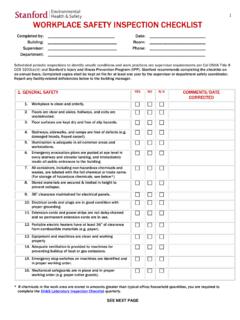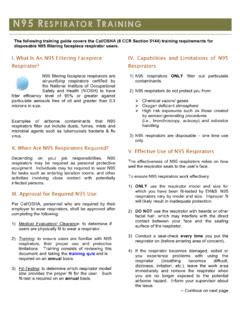Transcription of Sodium Hypochlorite (Bleach) Safety Fact sheet
1 Sodium Hypochlorite (Bleach) Safety Fact sheet Warning: May Not Play Well with DNA/RNA Kits Sodium Hypochlorite , the active ingredient in chlorine bleach, is routinely used in the laboratory to decontaminate surfaces and equipment or deactivate biological materials by inactivating vegetative bacteria, fungi, lipid and non-lipid viruses, and other liquid specimens. Bleach is very reactive and if it mixes with incompatible chemicals, it can produce high hazard by-products and toxic gases. What are the hazards of Bleach? Bleach is an oxidizer and corrosive.
2 Exposures may cause irritation or damage to the skin, eyes, and the respiratory tract. Vapors can cause serious discomfort or even acute distress requiring medical attention. LSP 20-116 DNA/RNA Kit Incompatible Warning: Some trademarked reagents and kits used in the lab may contain hazardous materials and/or ingredients that are incompatible with bleach. Many chemicals in these kits already contain a deactivating agent. Do not use bleach with these kits! Kit constituents that are incompatible with bleach Possible reactions and symptoms Alcohols , ethanol, methanol, isopropanol, propanol (may be found in buffers of binding beads such as QIAGEN kits and Blood & Cell culture kits) Forms chloroform, hydrochloric acid, chloroacetone or dichloroacetone.
3 Low levels of chloroform exposure could result in fatigue, dizziness, and headache. Elevated levels of chloroform may damage the liver and kidneys. Guanidine Salts , guanidine hydrochloride, guanidinium chloride, guanidine thiocyanate, guanidine isothiocyanate (found in lysis and wash buffers, which also contains phenol. Products include Qiagen kits, lysis buffers, and TRIzol RNA Purification Kits) Forms toxic gases ( , chloramine, chlorine, and hydrogen cyanide) and can form highly reactive compounds. Low levels of exposure may result in eye and oral mucous membrane irritation, dizziness and nausea - while exposure to high levels may be fatal.
4 Always review the Safety Data sheet (SDS) and the manufacturer s guidelines to determine the chemical compatibility of chemicals or proprietary material with the deactivating agent. Bleach is incompatible with many chemicals found in the laboratory and DNA/RNA kit components. Mixing bleach with incompatible chemicals can produce toxic gases that can potentially damage the eyes, skin, lungs, vocal cords, nervous system, liver, and kidneys. Bleach Incompatibilities The following list is not exhaustive and includes commonly encountered chemicals used in the laboratory.
5 LSP 20-116 Bleach-incompatible chemicals and materials Possible reactions and symptoms from mixing with bleach Acids and acidic compounds , hydrochloric acid, sulfuric acid, hydrofluoric acid, phosphoric acid, aluminum chloride Forms toxic chlorine gas. Low levels of exposure may result in eye and oral mucous membrane irritation, dizziness, and nausea - while exposure to high levels may be fatal. Alcohols , ethanol, methanol, isopropanol, and propanol Forms chloroform, hydrochloric acid, chloroacetone or dichloroacetone. Low levels of chloroform exposure could result in fatigue, dizziness, and headache.
6 Elevated levels of chloroform may damage the liver and kidneys. Ammonia-containing compounds , Ammonium chloride, ammonium sulfate, quaternary ammonium salts Forms toxic chlorine and chloramine gases. Low levels of exposure may result in eye and oral mucous membrane irritation, dizziness, and nausea - while exposure to high levels may be fatal. Guanidine Salts , Guanidine hydrochloride, guanidinium chloride, guanidine thiocyanate Forms toxic gases ( , chloramine, chlorine, and hydrogen cyanide) and can form highly reactive compounds. Low levels of exposure may result in eye and oral mucous membrane irritation, dizziness, and nausea - while exposure to high levels may be fatal.
7 Metals Stainless steel, iron, copper, nickel Mixing with bleach releases oxygen in a closed system ( , piping, equipment) which can lead to pressure build-up and rupture. Bleach will corrode metal including metal wastewater pipes. Organic chemicals , Organic solvents and polymers, amines, ethylene glycol, formic acid, insecticides, fuels and fuel oils Forms chlorine gas, and chlorinated organics which are toxic and/or carcinogenic. Low levels of exposure may result in eye and oral mucous membrane irritation, dizziness, and nausea - while exposure to high levels may be fatal.
8 Reducing agents , Sodium bisulfite, Sodium hydrosulfate, Sodium sulfate Boiling or splashing hazard if mixed with bleach. Safe Work Practices Proper concentrations For disinfection of most biologicals (Exception: prions and prion-like proteins), after dilution , working bleach solutions must contain between and 2% Sodium Hypochlorite to be an effective disinfectant. Hypochlorite concentration in household bleach varies by manufacturer. Many household bleach solutions contain Sodium Hypochlorite , and a 1:10 dilution (5250 ppm Cl) will produce a Hypochlorite solution.
9 Use of bleach solutions with lower Hypochlorite 1concentrations will not provide the proper level of disinfection. Bleach is not stable at dilute concentration. Users should prepare a fresh bleach solution regularly. Prepare a fresh working dilution of Sodium Hypochlorite weekly and indicate the preparation date on the bottle. Chlorine ( Hypochlorite ) compounds are effective in inactivating vegetative bacteria, fungi, lipid and non-lipid viruses, Coxiella burnetii and Tuberculosis. Chlorine compounds have some effect in inactivating bacterial spores: Recommended working dilution : 5250 ppm (1:10 dilution of household bleach of Sodium Hypochlorite ) Recommended for floors, spills (inactivating liquid specimens), bench tops and contaminated clothing.
10 Do not use bleach on electronic equipment, optical equipment or unpainted stainless steel Undiluted bleach and other disinfectants must not go down the drain or be mixed with other materials Only 1:10 dilutions of bleach that have been mixed with adequate levels of protein (such as those found in tissue culture media containing fetal bovine serum) can be poured down the drain Undiluted bleach is substantially more reactive than diluted bleach, and has even been reported to generate toxic gases such as cyanogen and chloramine when mixed with Luria broth in a ~1:1 ratio Refer to the Biosafety Manual for additional information and guidance on selecting appropriate disinfectants, or for appropriate bleach use with prions and prion-like proteins.






